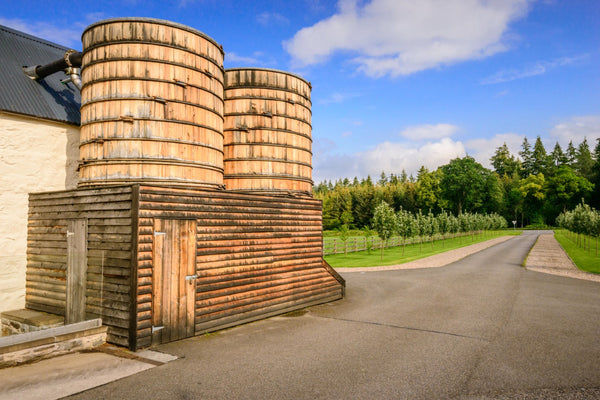The Scotch Whisky Distilleries Using Worm Tub Whisky Condensers
Aug 16, 2023
In our recent blog post on tthe importance of copper contact in whisky distillation, we explored how it influences the character of Scotch whisky. A key factor in this process is the type of condenser used, with two main systems in operation today: shell and tube condensers and worm tub condensers.
Shell and tube condensers, the more modern of the two, are widely favoured in the industry due to their ease of maintenance and reputation for providing greater copper contact, which helps refine the spirit. As a result, they have largely replaced the traditional worm tub condensers.
However, some distilleries continue to use worm tubs, valuing the distinct influence they have on whisky’s texture and flavour. Whiskies from worm tub distilleries are often described as meaty, sulphury and texturally rich. Below, we’ve compiled a list of 20 Scotch whisky distilleries that still use worm tub condensers today.
1. Ardnahoe
Founded in 2017 by Hunter Laing & Company, Ardnahoe illustrates that it is not just the older, established distilleries holding on to their worm tubs. Unique on Islay in using traditional worm tubs, they say: “This style of condensing used to be common throughout Scotland but fell somewhat out of favour in the 20th century because its use necessitates particularly slow distillation. Whilst the accountants may not share our enthusiasm, we believe the benefits of this less efficient method will ultimately be apparent in the glass!”
2. Ballindalloch
Another new distillery (founded in 2014 by the Macpherson-Grant family), Ballindalloch runs its wooden worm tub condensers slightly hotter than usual to increase conversion between the cooling spirit vapours and the copper.
3. Balmenach
Owned by Inver House Distillers, Balmenach is not currently represented by an official single malt. Caorunn gin operates out of the same production site.
4. Benrinnes
Owned by Diageo, most of the production at Benrinnes goes into blended whiskies such as Johnnie Walker, J&B and Crawford’s 3 Star. Most of the Benrinnes single malt is produced through independent bottlings, with the only official single malt being the Flora and Fauna 15 year old.
5. Brora
Also owned by Diageo, this legendary distillery was reopened in 2021 after a 3 year renovation project having been mothballed since 1983. Traditional production methods are still being used including their worm tub condensers.
Master Distiller Stewart Bowman commented, "The worm tubs that existed in 1983 had been removed as they were in a state of disrepair. These were replaced using existing archive information that allowed us to recreate them as closely as possible to what existed before.’’
6. Cragganmore
Cragganmore is an example of a Diageo-owned distillery which has replaced its traditional copper worms with new tubs made from stainless steel (in spring 2022).
7. Craigellachie
One of five distilleries owned by John Dewar & Sons, Craigellachie is the only one to use traditional worm tubs to condense its spirit vapours. Again, the tubs were upgraded to stainless steel in 2014 but the original copper worms were kept.
8. Dalwhinnie
Situated high in the Grampian mountains, Diageo’s Dalwhinnie arguably set the precedent for distilleries being minded to stick with their worm tubs. In the 1990s, the distillery famously switched to the more modern shell and tube condensers only to find that the character of their new make spirit was drastically altered. The worm tubs were swiftly reinstalled!
9. Edradour
Known as “Scotland’s little gem”, Edradour retains its authentic small-scale production of handmade single malt whisky from a farm distillery dating back to 1825. Two wooden worm tubs with coiled copper pipes are water cooled from the nearby Edradour Burn.
https://www.edradour.com/explore
10. Glen Elgin
Another of Diageo’s single malt distilleries, Glen Elgin has been a major contributor to blends (notably White Horse). Its six small stills connect to six traditional wooden worm tubs.
11. Glenkinchie
A recently refurbished brand home in Diageo’s “four corners of the Johnnie Walker blend” approach, Glenkinchie has kept its traditional worm tubs.
12. Knockdhu
Traditionally used in blended whiskies, it wasn’t until a buy over from Inver House Distillers that prompted the release of AnCnoc, their single malt whisky. Traditional worm tubs help create their sulphury new make spirit
13. Mortlach
Does Diageo love a worm tub? It would certainly seem so, Mortlach’s three wash stills and three spirit stills connect to traditional wooden tubs.
14. Oban
One of Diageo’s most visited distilleries, Oban largely produces for the single malt market rather than for use in blends. Here, one wash still and one spirit still connect to stainless steel worm tubs.
15. Pulteney Distillery
Home of the renowned Old Pulteney Single Malt and owned by Inver House Distillers, stainless steel worm tubs are in use here.
16. Royal Lochnagar
Thanks to a visit from Queen Victoria and Prince Albert in 1848, Royal Lochnagar was an official supplier to the Royal Family for the best part of a century. Founded in 1845, cast iron worm tubs are used at this Diageo distillery.
17. Speyburn
Also owned by Inver House Distillers, Speyburn actually use both types of condenser. Their wash still connects to a modern shell and tube system, while two spirit stills connect to traditional worm tubs.
18. Springbank
One of only three distilleries in the Campbeltown region (with plans to introduce more afoot), and the only Scottish distillery to perform every step in the whisky-making process, from malting the barley to bottling the spirit. Springbank uses a worm tub to condense the vapours from the first of its two spirit stills.
19. Talisker
One third of Diageo’s malt distilleries have worm tubs (including all of the original Classic Malts except Lagavulin). All five stills at Talisker (two wash and three spirit) connect to worm tubs.
20. Rosebank
This Falkirk-based distillery was said to achieve its signature style through a combination of triple distillation and worm tub condensing. By all accounts Ian Macleod (the new owners) are trying to recreate an exact replica process with both triple distillation and worm tub condensers.
Why Are Worm Tub Whisky Condensers Important?
Worm tub condensers play a vital role in traditional Scotch whisky production by slowing the cooling process and reducing copper contact. This unique method results in a heavier, meatier spirit with robust flavours, setting worm tub whisky apart from those made using modern condenser systems. These distilleries preserve a key aspect of Scotland's whisky-making heritage.




1 comment
Reading your article on wormtubs and it only lists 8 or am I missing something? https://www.edinburghwhiskyacademy.com/blogs/feature/the-scotch-whisky-distilleries-using-worm-tub-condensers